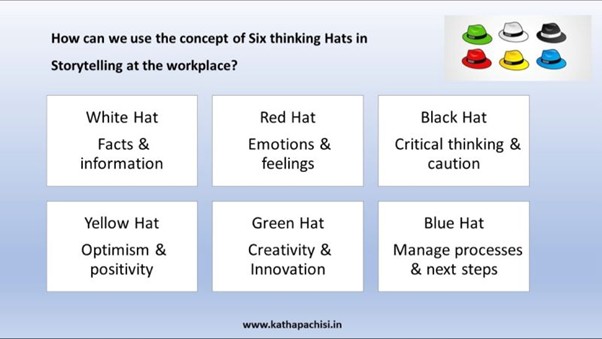Six thinking Hats

The “Six Thinking Hats” is a method introduced by Edward de Bono that encourages parallel thinking and helps teams consider problems from multiple perspectives. While this technique is traditionally associated with problem-solving and decision-making, its principles can be adapted and applied to enhance the storytelling and story crafting process. Let’s see how we can use the concept of Six Thinking Hats in storytelling while sharing stories at the workplace? ⚪️ White Hat (Facts and Information): 1. Focus on gathering and presenting factual information relevant to the story.2. Ensure that the narrative is grounded in reality and supported by accurate data.3. Use this hat to provide background, context, and essential details. 🔴 Red Hat (Emotions and Feelings): 1. Explore the emotional impact of the story on the audience.2. Consider the feelings and reactions that the story aims to evoke.3. Use vivid language and sensory details to create emotional connections. ⚫️ Black Hat (Critical Thinking and Caution): 1. Assess potential challenges or drawbacks in the story.2. Identify areas that might confuse or disengage the audience.3. Consider criticisms constructively to strengthen the overall narrative. 🟡 Yellow Hat (Optimism and Positivity):1. Emphasize the positive aspects and benefits of the story.2. Highlight opportunities, achievements, and uplifting elements.3. Encourage an optimistic perspective to inspire and engage the audience. 🟢 Green Hat (Creativity and Innovation): 1. Generate creative ideas to enhance the storytelling experience.2. Explore alternative plotlines, character developments, or storytelling techniques.3. Encourage out-of-the-box thinking to make the story more unique and compelling. 🔵 Blue Hat (Meta-Cognition and Process Control): 1. Reflect on the overall structure and purpose of the story.2. Consider the pacing, flow, and coherence of the narrative.3. Use this hat to guide the storytelling process and ensure a well-organized and impactful story. By applying the Six Thinking Hats framework to storytelling, we can encourage a comprehensive exploration of different aspects of the narrative. This approach helps storytellers view their stories from various angles, promoting creativity, critical thinking, and a more well-rounded and engaging storytelling experience for the audience. Katha Pachisi – The Story Bank
𝐔𝐧𝐥𝐞𝐚𝐬𝐡 𝐘𝐨𝐮𝐫 𝐋𝐞𝐚𝐝𝐞𝐫𝐬𝐡𝐢𝐩 𝐒𝐮𝐩𝐞𝐫𝐩𝐨𝐰𝐞𝐫: 𝐒𝐭𝐨𝐫𝐲𝐭𝐞𝐥𝐥𝐢𝐧𝐠

Did you know that 92% of executives believe storytelling is vital for leadership success? Imagine being in a room full of people, all eyes on you. What makes you stand out as a leader? It’s not just your title or looks—it’s your ability to connect with people, inspire them and guide them.For leaders, being able to tell a good story is super important. It helps them engage with people, inspire them to do great things and build strong relationships. So, what makes a good story? First off, it needs to be relatable. People want to hear stories that they can connect with, that make them feel like they’re part of something bigger. A good story also needs to be clear and easy to understand. You don’t want people scratching their heads trying to figure out what you’re talking about! And most importantly, a good story needs to have a point. It should leave people feeling inspired or motivated to take action.Great leaders use effective communication techniques to inspire their teams to action. Sharing purpose-driven stories, and experiences persuade and help to drive the message in a relatable way. Gravitas denotes the depth of personality, the leader’s wisdom, and the ability to maintain composure in difficult situations and make decisions. Leaders with gravitas capture attention and build trust with their stories. Leading with stories adds authenticity and conviction to your message, making it memorable and inspiring. Sylvia Ann Hewlett once said, “How you act (gravitas), how you speak (communication), and how you look (appearance) count for a lot in determining your leadership presence.” Incorporating storytelling boosts your gravitas and leaves a lasting impact. 𝐇𝐞𝐫𝐞 𝐚𝐫𝐞 𝐭𝐡𝐫𝐞𝐞 𝐬𝐢𝐦𝐩𝐥𝐞 𝐤𝐞𝐲𝐬 𝐭𝐨 𝐛𝐞𝐜𝐨𝐦𝐢𝐧𝐠 𝐚 𝐛𝐞𝐭𝐭𝐞𝐫 𝐥𝐞𝐚𝐝𝐞𝐫 𝐭𝐡𝐫𝐨𝐮𝐠𝐡 𝐬𝐭𝐨𝐫𝐲𝐭𝐞𝐥𝐥𝐢𝐧𝐠: 1. 𝐄𝐦𝐨𝐭𝐢𝐨𝐧𝐬: Share stories that touch people’s hearts and make them feel connected to your vision. 2. 𝐕𝐨𝐢𝐜𝐞: Speak with confidence and warmth to keep your team engaged and inspired. 3. 𝐁𝐨𝐝𝐲 𝐋𝐚𝐧𝐠𝐮𝐚𝐠𝐞: Stand tall, smile, and make eye contact to show that you’re approachable and confident. Remember, it’s not just about you. Encourage everyone in your team to share their stories and experiences. When everyone feels valued, your team will work better together. 𝐒𝐭𝐚𝐫𝐭 𝐲𝐨𝐮𝐫 𝐬𝐭𝐨𝐫𝐲𝐭𝐞𝐥𝐥𝐢𝐧𝐠 𝐣𝐨𝐮𝐫𝐧𝐞𝐲 𝐭𝐨𝐝𝐚𝐲 𝐚𝐧𝐝 𝐰𝐚𝐭𝐜𝐡 𝐲𝐨𝐮𝐫 𝐥𝐞𝐚𝐝𝐞𝐫𝐬𝐡𝐢𝐩 𝐬𝐤𝐢𝐥𝐥𝐬 𝐠𝐫𝐨𝐰. So, next time you’re in a leadership role, remember the power of storytelling. It might just be the secret ingredient you’ve been looking for!
The Transformative Impact of Storytelling – A Deep Dive into Leadership Challenges
In today’s dynamic world of leadership, where challenges are ever-present and the future is uncertain, one age-old tradition stands out as a powerful tool: storytelling. Although often linked with childhood memories and bedtime routines, storytelling holds a significant place in the realm of leadership. It’s more than just recounting tales; it’s a means of forging connections, igniting inspiration, and guiding teams through the complexities they encounter. Let’s explore further how storytelling can truly revolutionize leadership, especially in times of turbulence and uncertainty. Building Trust and Connection- Humanizing Leadership Trust and connection are vital in leadership. But let’s be real, it’s not always easy to build those bonds in the busy corporate world. That’s where storytelling comes in handy. When leaders open up and share their own experiences—the good, the bad, and the ugly—it creates a genuine connection with their teams. It’s like saying, “Hey, I’m just like you.” This honesty builds trust and a sense of teamwork, making the boss feel more like a friend than just someone in charge. Communicating Vision and Values- The Power of Narrative Visionary leaders understand the importance of articulating a compelling vision that inspires and motivates their teams. However, simply stating objectives and goals may not be enough to ignite the passion and commitment required for success. Storytelling provides a powerful vehicle for communicating vision and values in a way that resonates deeply with team members. By weaving narratives that illustrate the organization’s purpose, leaders can evoke emotions and create a sense of shared purpose that propels their teams forward. Inspiring Change and Resilience- Lessons from Stories Change is a constant in today’s business world, and leaders must be resilient and adaptable to navigate through it. Storytelling provides a platform for leaders to share stories of past challenges and successes, offering valuable lessons and insights to inspire their teams. These narratives remind everyone of their collective strength and ability to overcome obstacles, fostering confidence and resilience in the face of uncertainty. Fostering Learning and Development- The Storytelling Classroom Great leaders are committed to the growth and development of their teams, and storytelling provides a powerful tool for facilitating learning and personal development. By sharing stories of both success and failure, leaders create opportunities for reflection, growth, and continuous improvement within their teams. These stories serve as teaching moments, imparting valuable lessons and insights that inspire curiosity, creativity, and innovation. Building a Strong Organizational Culture- Stories as Cultural Cornerstones Organizational culture forms the foundation of a successful workplace, shaping behaviors, attitudes, and norms. Storytelling is pivotal in establishing and reinforcing this culture by sharing narratives that embody the organization’s values, traditions, and collective experiences. Through storytelling, leaders can strengthen the bonds that unite their teams, fostering a sense of belonging, pride, and purpose that goes beyond individual roles and responsibilities. Conclusion: In the complex world of leadership, storytelling acts as a unifying force that brings teams together, guiding them through challenges, sparking change, and nurturing a culture of growth and resilience. Embracing storytelling allows leaders to humanize their approach, effectively communicate their vision and values, instill resilience, promote continuous learning, and reinforce organizational culture. It’s more than just narrating tales; it’s about forging meaningful connections, igniting inspiration, and steering teams towards common objectives. Let’s harness the transformative influence of storytelling to lead with authenticity, empathy, and purpose, thus shaping a brighter future for both our organizations and teams.

